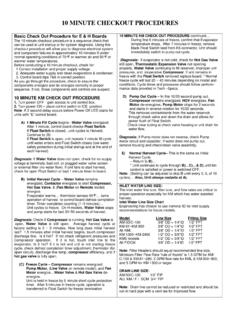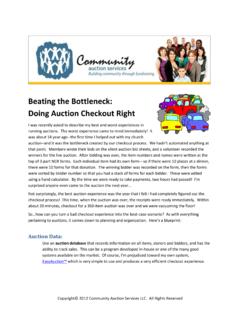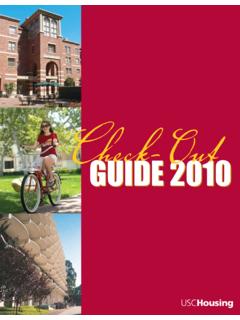Transcription of How To: Manage Problem Behaviors: Check-In/Check-Out
1 How the Common Core Works Series 2014 Jim Wright 1 how to : Manage Problem Behaviors: Check-In/Check-Out Students can be motivated to improve classroom behaviors if they have both a clear roadmap of the teacher's behavioral expectations and incentives to work toward those behavioral goals. This modified version of Check-In/Check-Out (CI/CO) is a simple behavioral intervention package designed for use during a single 30- to 90-minute classroom period (Dart, Cook, Collins, Gresham & Chenier, 2012).
2 The teacher checks in with the student to set behavioral goals at the start of the period, then checks out with the student at the close of the period to rate that student's conduct and award points or other incentives earned for attaining behavioral goal(s). Preparation. In preparation for using CI/CO, the teacher: selects 3 to 4 behaviors to be targeted during the intervention. Whenever possible, these should be stated positively as DO behaviors ( , "Promptly and quietly follow teacher requests") rather than DON'T behaviors ( , "Don't dawdle or talk back when given a teacher request").
3 Creates a behavior Report Card (BRC) that incorporates the 3-4 target behaviors. A behavior Report Card is a rating scale that the teacher uses to rate the student's behavior at the end of the class session or other evaluation period. A generic BRC suitable for use in Check-In/Check-Out appears elsewhere in this document. Teachers can also create customized BRCs for free at: decides on a daily reward/incentive that the student will earn if successful in displaying positive behaviors ( , 5 minutes of free time; 3 'positive behavior points' to be redeemed in future for rewards from a prize box; parent phone call praising student).
4 Sets a minimum rating on the BRC items that the student must attain to earn the selected reward/incentive. meets with the student to explain the intervention, review behavioral expectations, demonstrate how the behavior Report Card is to be filled out, and explain how the student can earn a daily reward/incentive. Procedure. During any class session or other evaluation period when CI/CO is in effect, the teacher follows these 3 steps: 1. check -In. At the start of the class session, the teacher meets briefly with the student to review the behavioral goals on the behavior Report Card and to provide encouragement.
5 The teacher also prompts the student to set a behavioral goal on at least one of the target behaviors ( , "Today I will not leave my seat once without permission."). 2. Monitoring/Evaluation. During the session, the teacher observes the student's behaviors. At the end of the session, the teacher rates the student's behaviors on the behavior Report Card. 3. check -Out. At the end of the class session, the teacher again meets briefly with the student. The student reports out on whether he or she was able to attain the behavioral goal(s) discussed at check -in. The teacher then shares the BRC ratings.
6 If the student has earned a reward/incentive, the teacher awards that reward and praises the student. If the student fails to earn the reward, the teacher provides encouragement about success in a future session. How the Common Core Works Series 2014 Jim Wright 2 Reference Dart, E. H., Cook, C. R., Collins, T. A., Gresham, F. M., & Chenier, J. S. (2012). Test driving interventions to increase treatment integrity and student outcomes. School Psychology Review, 41, 467-481. Check-In/Check-Out : behavior Report Card Student Name:_____ Grade: _____ Person Completing This Report Card: _____ Directions: At the end of each school day, please rate the student on the behaviors below.
7 Write your ratings into the appropriate box on the right of the page and record the date of each rating. You may also write daily comments about the student s behavior on the back of this sheet. Student Behaviors MON __/__/__ TUES __/__/__ WED __/__/__ THURS __/__/__ FRI __/__/__ The student got along with classmates and used socially appropriate behaviors. 1 2 3 | 4 5 6 | 7 8 9 Never/Seldom Sometimes Most/All of the Time The student was respectful to the teacher and other adults and complied with their requests in a timely manner. 1 2 3 | 4 5 6 | 7 8 9 Never/Seldom Sometimes Most/All of the Time The student paid attention to teacher instructions and classroom lessons and focused on his/her work assignments.
8 1 2 3 | 4 5 6 | 7 8 9 Never/Seldom Sometimes Most/All of the Time The student completed and turned in classwork and homework assignments. 0-19% 20-39% 40-59% 60-79% 80-100% (Optional behavior ) _____ _____ 1 2 3 | 4 5 6 | 7 8 9 Never/Seldom Sometimes Most/All of the Time Parent Sign-Off (Optional): I have reviewed this behavior Report Card and discussed it with my child. Parent Signature: _____ Date: _____Check-In/ check -Out: behavior Report Card: Progress-Monitoring Chart Directions: Plot daily teacher DBRC ratings and summarize notable teacher comments on the progress-monitoring charts below.
9 1 2 3 4 5 6 7 8 9 1 2 3 4 5 6 7 8 9 M T W Th F M T W Th F 1 2 3 4 5 6 7 8 9 M T W Th F M T W Th F Usually/Always Sometimes Never/Seldom Usually/Always Sometimes Never/Seldom The student got along with classmates and used socially appropriate behaviors. 1 2 3 4 5 6 7 8 9 1 2 3 4 5 6 7 8 9 M T W Th F M T W Th F 1 2 3 4 5 6 7 8 9 M T W Th F M T W Th F Usually/Always Sometimes Never/Seldom Usually/Always Sometimes Never/Seldom The student was respectful to the teacher and other adults and complied with their requests in a timely manner.
10 M T W Th F M T W Th F M T W Th F M T W Th F Wk 1: ___ / ___ / ___ Wk 2: ___ / ___ / ___ Wk 3: ___ / ___ / ___ Wk 4: ___ / ___ / ___ Start Date: Student Name: _____ 1 2 3 4 5 6 7 8 9 1 2 3 4 5 6 7 8 9 M T W Th F M T W Th F 1 2 3 4 5 6 7 8 9 M T W Th F M T W Th F Usually/Always Sometimes Never/Seldom Usually/Always Sometimes Never/Seldom The student paid attention to teacher instructions and classroom lessons and focused on his/her work assignments.



















